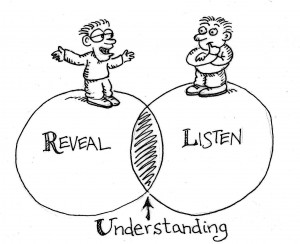“I cannot figure out why they wouldn’t go with our program, when I know it will help them.”
 What is obvious to you is not obvious to your client. You cannot solve a problem for your clients until your client has discovered they have a problem or a need, first.
What is obvious to you is not obvious to your client. You cannot solve a problem for your clients until your client has discovered they have a problem or a need, first.
This is the failing of far too many sales professionals—pitching, presenting, or offering a program that their prospective clients do not believe or understand they need. There have been a great deal of training programs that embrace the process of creating a need, even where there isn’t one – I am proudly not one of them. I do not believe in creating a need, simply because I believe should be one.
I am a bigger proponent of first understanding why the client doesn’t see the need, then proceeding with a course of conversation that works towards offering the client an opportunity to discover a need. Once I have gone through this process, if there is no agreement that there is a problem to solve or a need to fulfill, there is no opportunity to solve.
Here is how I approach this process:
- Understand what I don’t know: There is likely a reason the prospective client doesn’t see the problem or believe there is a need. It is not my job to tell him all the reasons why he should be interested—it is my job to understand why he isn’t interested. I need to know and understand his world, his experiences, and his drivers from his perspective – not mine. When I understand what drives, inspires, and blocks him, only then do I have the knowledge of his perspective. Remember, I am there to help him, not me. I cannot help him. If I don’t understand.
- Explore the situation with the client: There are many great benefits in our products and services that would solve or avoid a problem. Whether we can help our client manage their business better, be in better regulatory compliance, etc. doesn’t matter. We can pound on the table and share all the ways we can help; but, until your client wants it, he won’t buy it – and you need not try to make him. Go through the process of developing a series of great, exploratory questions that engage your client in a conversation around the issues that the features and benefits of your product help with. Learn to ask open ended questions about the solutions you might provide and get your clients perspectives on the importance, value, interest, and opportunity in those offerings. It is a much better approach than advocating why they need to be interested in them. The more creative, probing, and intelligent the questions, the more likely your prospective client will realize they don’t know as much about this subject as they would like. And, they may discover an interest in learning more; or, uncover an issue they didn’t realize they were inadvertently ignoring.
- Offer to help: Once your client expresses interest in learning more, you are now in a position to share, enlighten and help. Instead of pitching or advocating, you are educating, advising, and solving. Having gone through this discovery and learning process with your ears and your mind open, you are now communicating from a common ground of knowledge and understanding. This is where powerful and productive deals are made.
Next time you find yourself saying, “I just don’t understand why he isn’t interested” you are probably right – you don’t.
Congratulations
Your first AWS Elastic Beanstalk Node.js application is now running on your own dedicated environment in the AWS Cloud
This environment is launched with Elastic Beanstalk Node.js Platform
What’s Next?
- AWS Elastic Beanstalk overview
- AWS Elastic Beanstalk concepts
- Deploy an Express Application to AWS Elastic Beanstalk
- Deploy an Express Application with Amazon ElastiCache to AWS Elastic Beanstalk
- Deploy a Geddy Application with Amazon ElastiCache to AWS Elastic Beanstalk
- Customizing and Configuring a Node.js Container
- Working with Logs
